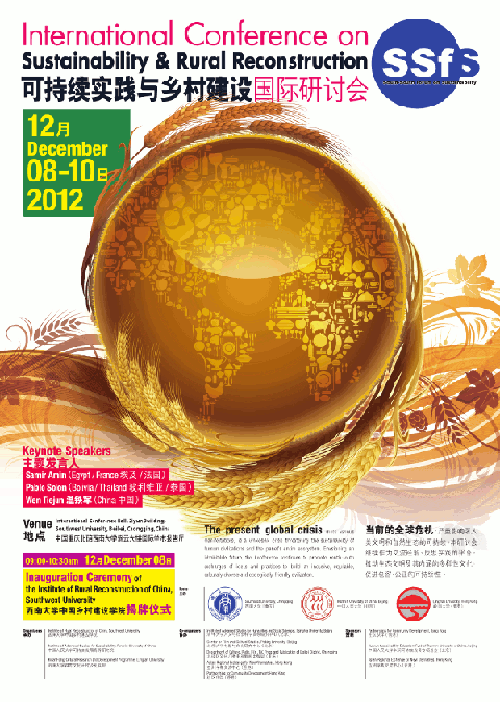Event Title
2012 International Conference on Sustainability & Rural Reconstruction
Start Date
9-12-2012 2:00 PM
End Date
9-12-2012 3:15 PM
Language
English
Description
Before 1990 the production and market of vegetables in Cuba was monopolized by a large state enterprise where horticultural techniques such as hydroponics and zeoponics are used (in zeolite subtract) with heavy use of chemical products. But, in 1991 due to the Collapse of Soviet Socialist System in Eastern Europe, the Cuban agriculture enters into crisis. Without chemicals pesticides and fertilizers, metal containers, and cement, the hydroponic-zeolite technology could not be used anymore. In this context, the Movement of Urban Agriculture was born in which people produce fresh vegetables intensively applying agro-ecological principles and Organic techniques, consume and directly sell the produce. The Word Health Organization (WHO) and Food and Agriculture Organization (FAO) recommend eating ≥400 g per day of fruits and vegetables (not counting potatoes and other starchy tubers such as cassava). In 1998 the Program produced 75% of the fresh vegetables consumed in the country, that represented 215 grams day per person, and in 2002 it produced 2360.1 tons that represented 576 g day per person. In 2011 the Cuban Urban agriculture produced 1 million 93 mill tonnes of fresh fruit and vegetables. First of all, this impact brings a new perspective to urban reliance opposing a global trend that rural population feeds urban population. Precisely, the main objective of this paper is to show how the Urban Agriculture Movement in Cuba has been successful through developing its potentials to feed its population sustainably. Economically, urban agriculture production permits also production of seeds that the island could start to rely on local production, and at the same time, reduce expenditure by use of biological pest control and organic fertilizers, as much 39 million USD in a year. It is also avoids turning garbage dump into organic gardens in order to reduce pollution in the cities. Finally, this movement constitutes a new source of job opportunities and income to the urban population. The recent International Forum on statement on Nutrition Security of Urban Populations that was celebrated in September 2012, in Naples, Italy, declared that Urban agriculture should be contributed to food availability, food security and nutrition of urban and rural dwellers. It is clear as well, that by using space in cities to grow fruit and vegetables, the ecological footprint could be reduce. The Cuban Urban and Suburban Movement offer facts and arguments to support this hope. The data and facts are collected through continuous investigation and field research in the past five years, and they are discussed in length in book written by the authors: Unfinished Puzzle, Cuban Agriculture: The challenges, lessons and opportunities, edited by Food First, Print in Canada, 2012.
在1990年以前,古巴的蔬菜市场由一国企独家垄断,在种植过程中大量运用化学制品。1991年,东欧社会体制解体,古巴农业陷入危机。没了杀虫剂和化肥,没了金属容器,没了水泥,之前的种植方式无以为继。在这个环境下,城市农业诞生了:人们运用生态农业原则和有机种植方式生产新鲜蔬菜,自种自吃,余下的用来出售。世界卫生组织和粮农组织建议每日食用不少于400g的蔬果(不包括土豆及其它淀粉质块茎)。在1998年,此项目生产的蔬菜占全国消费量的75%,即平均为每人提供了215g的蔬菜。到了2002年,生产总量达230.1吨,即平均为每人每天提供576g蔬果。在2011年,古巴的城市农业生产总量为1,093,000吨。其重要性首先在于,冲击了认为城市人口必须靠农村来养活的固有成见。本文的主要目的在于揭示古巴的城市农业运动是如何成功地发展最大潜力,可持续地养活人民大众。从经济观点来看,这场生产运动使农业留种亦成为可能,这个小岛终于可以开始依赖本地生产。同时,生产成本也得到了降低,因为采用的是生物技术的害虫防治以及有机肥。在这个过程中,垃圾不会被倒入土地,减轻了城市污染问题。最后,这场运动也为城市人口提供了新的就业岗位。2012年九月于意大利那不勒斯召开的“国际城市人口营养安全声明论坛”主张,城市农业必须能保障食物的获取与安全,保障城市和农村居民的营养摄入。另外很明显的一点是,利用城市用地来种植蔬果,碳排放亦会降低。古巴的城市与城郊运动为这一点提供了真实数据,这些数据是过去五年内通过长期实地勘察和数据研究取得的,并且在《未解释之谜,古巴农业:挑战,教训和机遇》(Food First出版,2012年加拿大印刷)一书中有详尽的探讨。
Document Type
Conference
Presentation Material
Recommended Citation
Freyre Roach, E. F., & Chan, M. L. (2012, December). Could cities feed themselves? The case of the urban agriculture movement in Cuba. Paper presented at 2012 International Conference on Sustainability & Rural Reconstruction, Southwest University, Chongqingng, China.
Included in
Demography, Population, and Ecology Commons, Growth and Development Commons, Other International and Area Studies Commons, Place and Environment Commons, Sociology of Culture Commons
Could cities feed themselves? The case of the urban agriculture movement in Cuba = 城市能否自给自足? 古巴城市农业运动调查报告
Before 1990 the production and market of vegetables in Cuba was monopolized by a large state enterprise where horticultural techniques such as hydroponics and zeoponics are used (in zeolite subtract) with heavy use of chemical products. But, in 1991 due to the Collapse of Soviet Socialist System in Eastern Europe, the Cuban agriculture enters into crisis. Without chemicals pesticides and fertilizers, metal containers, and cement, the hydroponic-zeolite technology could not be used anymore. In this context, the Movement of Urban Agriculture was born in which people produce fresh vegetables intensively applying agro-ecological principles and Organic techniques, consume and directly sell the produce. The Word Health Organization (WHO) and Food and Agriculture Organization (FAO) recommend eating ≥400 g per day of fruits and vegetables (not counting potatoes and other starchy tubers such as cassava). In 1998 the Program produced 75% of the fresh vegetables consumed in the country, that represented 215 grams day per person, and in 2002 it produced 2360.1 tons that represented 576 g day per person. In 2011 the Cuban Urban agriculture produced 1 million 93 mill tonnes of fresh fruit and vegetables. First of all, this impact brings a new perspective to urban reliance opposing a global trend that rural population feeds urban population. Precisely, the main objective of this paper is to show how the Urban Agriculture Movement in Cuba has been successful through developing its potentials to feed its population sustainably. Economically, urban agriculture production permits also production of seeds that the island could start to rely on local production, and at the same time, reduce expenditure by use of biological pest control and organic fertilizers, as much 39 million USD in a year. It is also avoids turning garbage dump into organic gardens in order to reduce pollution in the cities. Finally, this movement constitutes a new source of job opportunities and income to the urban population. The recent International Forum on statement on Nutrition Security of Urban Populations that was celebrated in September 2012, in Naples, Italy, declared that Urban agriculture should be contributed to food availability, food security and nutrition of urban and rural dwellers. It is clear as well, that by using space in cities to grow fruit and vegetables, the ecological footprint could be reduce. The Cuban Urban and Suburban Movement offer facts and arguments to support this hope. The data and facts are collected through continuous investigation and field research in the past five years, and they are discussed in length in book written by the authors: Unfinished Puzzle, Cuban Agriculture: The challenges, lessons and opportunities, edited by Food First, Print in Canada, 2012.
在1990年以前,古巴的蔬菜市场由一国企独家垄断,在种植过程中大量运用化学制品。1991年,东欧社会体制解体,古巴农业陷入危机。没了杀虫剂和化肥,没了金属容器,没了水泥,之前的种植方式无以为继。在这个环境下,城市农业诞生了:人们运用生态农业原则和有机种植方式生产新鲜蔬菜,自种自吃,余下的用来出售。世界卫生组织和粮农组织建议每日食用不少于400g的蔬果(不包括土豆及其它淀粉质块茎)。在1998年,此项目生产的蔬菜占全国消费量的75%,即平均为每人提供了215g的蔬菜。到了2002年,生产总量达230.1吨,即平均为每人每天提供576g蔬果。在2011年,古巴的城市农业生产总量为1,093,000吨。其重要性首先在于,冲击了认为城市人口必须靠农村来养活的固有成见。本文的主要目的在于揭示古巴的城市农业运动是如何成功地发展最大潜力,可持续地养活人民大众。从经济观点来看,这场生产运动使农业留种亦成为可能,这个小岛终于可以开始依赖本地生产。同时,生产成本也得到了降低,因为采用的是生物技术的害虫防治以及有机肥。在这个过程中,垃圾不会被倒入土地,减轻了城市污染问题。最后,这场运动也为城市人口提供了新的就业岗位。2012年九月于意大利那不勒斯召开的“国际城市人口营养安全声明论坛”主张,城市农业必须能保障食物的获取与安全,保障城市和农村居民的营养摄入。另外很明显的一点是,利用城市用地来种植蔬果,碳排放亦会降低。古巴的城市与城郊运动为这一点提供了真实数据,这些数据是过去五年内通过长期实地勘察和数据研究取得的,并且在《未解释之谜,古巴农业:挑战,教训和机遇》(Food First出版,2012年加拿大印刷)一书中有详尽的探讨。
